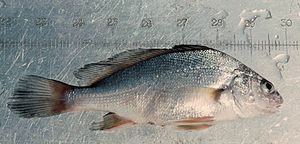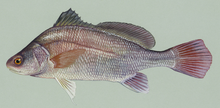Freshwater drummers
| Freshwater drummers | ||||||||||||
|---|---|---|---|---|---|---|---|---|---|---|---|---|

Freshwater drummers ( Aplodinotus grunniens ) |
||||||||||||
| Systematics | ||||||||||||
|
||||||||||||
| Scientific name of the genus | ||||||||||||
| Aplodinotus | ||||||||||||
| Rafinesque, 1819 | ||||||||||||
| Scientific name of the species | ||||||||||||
| Aplodinotus grunniens | ||||||||||||
| Rafinesque , 1819 | ||||||||||||
The freshwater drum ( Aplodinotus grunniens ) (Engl. Freshwater drum , croaker , grunt ) is one of the few species of croakers that live exclusively in freshwater. Its habitat are rivers and lakes in North America .
features
The majority of freshwater drummers reach a length of 30 to 70 centimeters and a weight of 0.45 to 3.5 kilograms. Larger and heavier specimens are known: In the summer of 2007, two freshwater drummers were caught below the Gavins Point Dam of the Missouri River on the Nebraska-South Dakota border, weighing 10.35 kg and 14.86 kg respectively. A specimen has also been caught from the Cahaba River in Alabama at the age of 32, and even a 72-year-old freshwater drummer from Red Lakes, Minnesota has been reported.
The high back and the flattened body are characteristic of the freshwater drummer. The color is mostly uniformly silvery, the back and upper body sides are often dark, the roots of the fins reddish, the dorsal and caudal fins can also be outlined in black. The large dorsal fin consists of the front spiky and the rear soft dorsal fin, both of which are separated from each other by a deep notch. The lateral line organ extends into the caudal fin. Like most umberfish, the freshwater drummer has strong pharyngeal teeth and can use them to crack hard-shelled prey. The ventral pharyngealia are fused, the teeth hemispherical. The swim bladder is large and undivided.
Sexually mature males have a sound system with which they form sounds during the reproductive period. The sound apparatus consists of two muscles ( drum muscles ), the fibers of which emanate from the inner wall of the body muscles and are connected to one another by a broad tendon (central tendon) that extends over the swim bladder. The drum muscles are reddish in contrast to the white body muscles during the spawning season.
The maze is well formed. The three arcades are the same size and arranged in three directions of the room. Dorsally, the semicircular canals are attached to the skullcap. The sacculus is exceptionally large, as is its ear stone ( sagitta ). The lateral side of this ear stone is irregularly shaped, while the medial side is slightly arched and smooth apart from a rough surface on the side of the middle. In addition, an L-shaped notch is regularly formed on the medial side. Caudally the sacculus is adjoined by the noticeably smaller lagena, which also contains an ear stone (asteriscus). The uriculus is located at the base of the semicircular canals and is separated from them. It also contains an otolith (lapillus). The age of a fish can be determined with the help of the ear stones.
Fin formula : D1 IX, D2 I / ~ 30, A II / 5-6.
Occurrence
The freshwater drummer inhabits lakes and rivers in North America. In the east-west direction it is distributed from the Appalachian Mountains to the Rocky Mountains , in the north-south direction from the Hudson Bay over North America to Guatemala . It has the largest range of all freshwater fish in North America. However, the distribution in this area is not extensive.
In the umberfish family, the freshwater drummer is an exception, as it lives in freshwater , like Plagioscion squamosissimus (Heckel, 1840) in South America . This makes it comparable to the burbot or trumpet, which is also native to freshwater as a representative of the codfish . One difference is that some umberfish penetrate brackish and fresh water, whereas cod do not.
Way of life, behavior
The food of the freshwater drummers mainly consists of insect larvae, amphipods and decapods , snails and freshwater mussels (e.g. migrating mussels ), whose hard shells it cracks open with its pharyngeal teeth . The pharyngeal teeth are only sufficiently developed to be able to crack mussels when the fish is 26 cm long. Only larger specimens over 37.5 cm in length feed mainly on migrating mussels. The freshwater drummer can only be used to a limited extent for the biological control of the reproduction of the migrating mussel introduced into the North American lake area. In addition, the freshwater drummers prey on smaller fish such as alosa , small carp- like fish and also juvenile fish of their own species. In contrast to most other predatory fish in freshwater, the freshwater drummer is nocturnal.
Freshwater drummers become sexually mature after 4 to 6 years ; the body length of the males is then at least 20 cm, that of the females at least 22 cm.
During the breeding season, the males emit their typical sounds (drum sounds), which are made up of short, similar impulses. Their repetition rate is around 25-30 Hz and is temperature-dependent. The duration of the sounds varies between 200 ms and 5 s; it is determined by the number of impulses per sound. With high acoustic activity, the duration of the sounds is long, but the intervals between them are short. The frequency spectrum of the sounds ranges from 100 to 2000 Hz. The main part of the sound energy is distributed over the range 200 to 300 Hz. According to current knowledge, the sounds serve to bring together males and females ready to spawn.
Depending on the latitude, spawning takes place from April to the end of June at water temperatures between 18 and 26 ° C. For spawning, the fish form groups of 15–30 animals that rise to the surface of the water and spawn there. The eggs develop pelagically , which is rarely the case in freshwater fish. They can be widespread by water currents within a lake or river. Large females lay up to 600,000 eggs.
use
The freshwater drummer is very popular with anglers in North America, but as a food fish it is spurned in many places due to its taste and slimy skin. In Lake Winnebago , Wisconsin , the freshwater drummers are plentiful and used economically, e.g. B. it is used in mink farms as feed for the rearing of the animals.
The earstones of the freshwater drummer were used as currency by the earlier inhabitants of North America and are still given away as lucky charms or turned into jewelry ( ivory-like ). As a find, alluvial ear stones of the saccule are particularly valued, because the L-shaped notch on the medial side is interpreted as "lucky". It is possible that the scientific name Aplodinotus , given by Rafinesque in 1819, can be interpreted from the ear stones : (h) aplo- "simple", din- "very large", -otos "-ohrig" (from οῦς, ὠτός ear, "ear stone").
Individual evidence
- ↑ Quoted from NEBRASKAland Magazine
- ↑ AL Rypel, DR Bayne and JB Mitchell: Growth of freshwater drum from lotic and lentic habitats in Alabama. Transactions of the American Fisheries Society, 135, pp. 987-997, 2006
- ↑ a b H. Schneider and AD Hasler: Lute and sound production in the fresh water drummer Aplodinotus grunniens Rafinesque (Sciaenidae, Pisces). Journal of Comparative Physiology , 43, pp. 499-517, 1960
- ^ H. Schneider: The labyrinth of two species of drumfish. Copeia, 1962, pp. 336-3438, 1962
- ↑ Texas Parks and Wildlife: Freshwater Drum (Engl.)
- ↑ JRP French, MT Bur: Predation of the Zebra Mussel (Dreissena polymorpha) by Freshwater Drum in Western Lake Erie. In: Zebra Mussels: Biology, Impacts, and Control . Pp. 453-464, Lewis Publishers, Boca Raton, 1993
- ↑ AL Rypel and Mitchell JB: Summer nocturnal patterns in fresh water drum (Aplodinotus grunniens) . American Midland Naturalist, 157, pp. 230-234, 2007
- ↑ Minnesota Department of Natural Resources, Nature Snapshots: Freshwater Drum (Eng.)
literature
- H. Schneider and AD Hasler: Lute and sound generation in the freshwater drummer Aplodinotus grunniens Rafinesque (Sciaenidae, Pisces). Journal of Comparative Physiology , 43, pp. 499-517, 1960
Web links
- Freshwater drum on Fishbase.org (English)
- Animal Diversity Web: Aplodinotus grunniens (English)
- Ohio Department of Natural Resources, Division of Wildlife: Short description (English)
- Aplodinotus grunniens inthe IUCN Red List of Threatened Species 2013.2. Posted by: NatureServe, 2011. Retrieved February 7, 2014.

